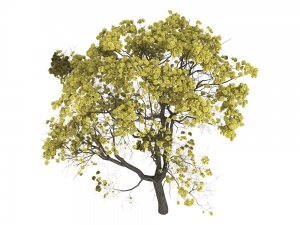Tabebuia avellanedae
| See Also | Botanical Monographs |
|---|
Pau d'arco (Tabebuia avellanedae) is used to treat many different types of infections including colds, flu, sore throat and yeast infections. To explore the characteristics, medicinal uses and prescribing considerations of this herb in more detail, check out the references indicated.[1], [2]
Contents
Characteristics
AKA Tahebuia impetignosa, T. ipe
- Common Names: Pau d'arco. La Pacho, Ipe Roxo
- Family: Bignoniaceae
- Habitat: Tabebuia chrysantha is native to South America in mountainous terrains and low-lying areas.
- Parts Used: Bark (especially the inner bark), heartwood, leaves
- Constituents: napthoquinones (lapachol, highest in the inner bark), anthraquinones (CoQ10), menaquinone (vitamin K), bioflavonoids, iridoids, coumarins, alkaloids, steroidal saponins
- Medicinal Actions: antimicrobial, antifungal, antiparasitic, :antineoplastic, cytotoxic, anti-inflammatory, immunostimulant, depurative, antioxidant, oestrogen modulating, antimalarial, antitumour,
Uses
Historical Uses:
Native South Americans consider Tabebuia chrysantha a cure-all, using it for wounds, skin diseases, snakebites, fever, malaria, intestinal problems, including dysentery and ulcers, and even some cancers.
Medicinal Uses:
- used to treat bacterial and viral infections especially of the upper respiratory tract)
- chronic fatigue syndrome (EBV), HSV, HIV
- Used to treat parasites and fungal infections, especially candida and tinea
- inflammatory problems especially involving the gastrointestinal tract, as well as cystitis, cervicitis, prostatitis
- Other Conditions
Prescribing Considerations
The information provided is intended to augment the treatment from a naturopathic doctor or other trained medical professional. Although most herbs are generally safe, it is recommended that you avoid self-prescribing especially when there is an underlying ongoing medical condition, if you are on any prescription medications or if you are pregnant or breastfeeding.
Formulations and Preparation
- Tincture - 3-7mL (1:2, 45%) daily
- Decoction - 10g/600mL (simmer 15 min, strain), drink throughout the day
- Cancer therapy - higher doses may be used
Napthoquinones are best extracted in ethanol; used in tincture and decoction forms.
Safety
The safety and prescribing considerations for this herb include:[3] [4]
- Generally regarded as safe unless large doses of lapochol are ingested.
- Side-effects are generally not seen.
- Contraindicated in pregnancy (speculative).
- Drug-Herb Interactions.[2]
- Anticoagulants - Concomitant use increases the potential for hemorrhage due to lapachol (speculative); use of the whole plant does not present this problem because the vitamin K is found in the bark.
- Cyclosporine and Corticosteroids - It may offset immunosuppression by these drugs (speculative based on in vitro immunomodulating activity).
References
- ↑ Boon Heather, Smith Michael (2009) 55 Most Common Medicinal Herbs: The Complete Natural Medicine Guide Second Edition Institute of Naturopathic Education and Research, CCNM Toronto.
- ↑ 2.0 2.1 Godfrey Anthony, Saunders Paul, Barlow Kerry, Gowan Matt (2011) Principles and Practices of Naturopathic Botanical Medicine, Advanced Botanical Medicine. V3 CCNM Press, Toronto.
- ↑ Stargrove Mitchell Bebell, Treasure Jonathan, McKee Dwight L (2008) Herb, Nutrient and Drug Interactions: Clinical Implications and Therapeutic Strategies.
- ↑ Brinker Francis (1997) Herbal Contraindications and Drug Interactions: Plus Herbal Adjuncts With Medicines, 4th Edition Eclectic Medical Publications.
